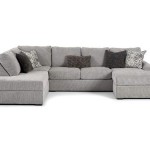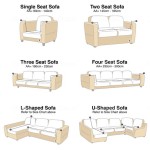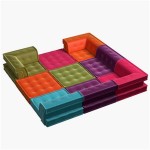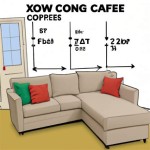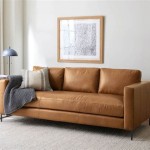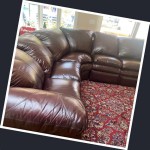Standard 3-Seat Sofa Length: A Comprehensive Guide
The three-seat sofa is a staple in living rooms worldwide. Its popularity stems from its balance between seating capacity and space efficiency. Understanding the standard length of a three-seat sofa is crucial for interior design considerations, particularly when planning room layouts and selecting furniture that complements the existing space. This article provides a detailed overview of standard three-seat sofa lengths, factors influencing these dimensions, and practical considerations for choosing the right sofa size for various living environments.
The term "standard" can be misleading, as sofa dimensions can vary slightly depending on the manufacturer, style, and design. However, there is a general range within which most three-seat sofas fall. This knowledge is essential for both consumers and design professionals to ensure a comfortable and aesthetically pleasing living space.
Understanding the Typical Length Range
A standard three-seat sofa typically ranges in length from 75 inches (6.25 feet) to 90 inches (7.5 feet). This range is based on accommodating three adults comfortably. However, it's important to note that some manufacturers may offer models slightly outside this range, particularly for more contemporary or custom designs. The depth, which refers to the distance from the front of the sofa to the back, usually falls between 32 and 40 inches, while the height, from the floor to the top of the back cushions, usually ranges from 30 to 36 inches. These dimensions, when considered collectively, contribute to the overall comfort and usability of the sofa.
Within this standard length range, variations exist. Sofas on the shorter end (75-80 inches) are often suitable for smaller apartments or rooms where space is limited. These sofas may also trade off length for a slightly deeper seat, providing enhanced comfort. Conversely, sofas on the longer end (85-90 inches) are better suited for larger living rooms, offering ample seating and potentially incorporating features like wider armrests or additional cushioning. The specific design of the sofa significantly impacts these measurements; for example, a sofa with rolled arms will typically have a greater overall length than one with track arms, even if the seating area is the same.
It’s also vital to distinguish between the overall length of the sofa and the seating area. The seating area refers to the space available for sitting, excluding the armrests and back cushions. A sofa with a long overall length may not necessarily have a proportionately large seating area if it features bulky armrests or a thick frame. When evaluating a sofa, it is important to consider both the overall dimensions and the usable seating space.
Factors Influencing Sofa Length
Several factors contribute to the variations in three-seat sofa lengths. These include style, frame construction, armrest design, and cushion type. Understanding how these elements interact is crucial for selecting a sofa that not only fits the available space but also meets personal comfort requirements.
The style of the sofa significantly influences its dimensions. Traditional sofas, for instance, often feature rolled arms, high backs, and ornate detailing, which can increase the overall length. Modern sofas, on the other hand, tend to have cleaner lines, lower profiles, and smaller armrests, resulting in a more compact design. Sectional sofas, while often composed of multiple pieces, also contribute to the variation in overall dimensions. A three-seat sectional piece may have a different length compared to a standalone three-seat sofa.
Frame construction also plays a role. Sofas with solid wood frames tend to be more robust, potentially requiring a slightly larger overall size to accommodate the structural components. Similarly, the type of suspension system used can affect the sofa's dimensions. Sofas with coil springs or sinuous springs may require additional space within the frame, impacting the overall length. The materials used in the framing and construction also influence the weight of the sofa, which is important to consider when moving or rearranging furniture.
Armrest design is a significant factor affecting the overall length of a sofa. Wide, rolled arms can add several inches to the sofa's width, while slim, track arms contribute to a more streamlined profile. Armless sofas, although less common, offer a unique solution for maximizing seating in tight spaces, eliminating the additional length associated with armrests. The height and depth of the armrests also contribute to overall comfort and ergonomics. Ideally, armrests should be at a comfortable height for resting arms and providing support. The shape and padding of the armrests also influence their overall size and contribution to the sofa's length.
Cushion type and thickness also contribute to the overall length. Thick, plush cushions can add to the overall depth and length of the sofa. Sofas with loose back cushions often have a slightly greater depth to prevent the cushions from sliding off. The material used for the cushions, such as down or foam, can also impact their overall volume and contribution to the overall dimensions. The firmness of the cushions can also affect the perceived size of the sofa; firmer cushions tend to maintain their shape better and may not compress as much, leading to a consistent overall size.
Practical Considerations for Choosing the Right Size
Choosing the right size three-seat sofa requires careful consideration of several factors, including room size, layout, traffic flow, and personal preferences. Measuring the available space accurately is essential to avoid purchasing a sofa that is too large or too small for the room. Planning the furniture layout beforehand can help visualize how the sofa will fit within the space and ensure adequate walkways and clearances.
Room size is the primary determinant of the appropriate sofa length. In smaller rooms, a compact three-seat sofa (75-80 inches) is often the best option to avoid overcrowding the space. Larger rooms can accommodate longer sofas (85-90 inches) without feeling cramped. It is crucial to consider the proportions of the room and choose a sofa that complements the other furniture and architectural features. For example, a long, low-profile sofa may be suitable for a modern, open-plan living room, while a more traditional sofa with higher arms and back may be better suited for a smaller, more formal living room.
Traffic flow is another essential consideration. The placement of the sofa should not obstruct pathways or create bottlenecks. Adequate space should be left around the sofa for people to move freely. This is especially important in high-traffic areas, such as the entrance to the living room or pathways to other rooms. Consider the placement of other furniture, such as coffee tables, side tables, and chairs, and ensure that there is enough space for comfortable movement between them. A well-planned layout will enhance the functionality and aesthetics of the living room.
Personal preferences also play a significant role in choosing the right sofa size. Some individuals prioritize maximum seating capacity, while others value comfort and style. If the sofa is primarily used for lounging and relaxation, a deeper seat and plush cushions may be preferred, even if it means sacrificing some floor space. Individuals who frequently entertain guests may opt for a longer sofa to accommodate more people. The overall aesthetic of the room should also be considered. A modern living room with minimalist decor may benefit from a sleek, streamlined sofa, while a more traditional living room may call for a sofa with classic features and a more substantial presence.
In conclusion, understanding the standard length range of three-seat sofas, the factors that influence their dimensions, and the practical considerations for choosing the right size is crucial for creating a comfortable and aesthetically pleasing living space. By carefully evaluating these aspects, consumers and design professionals can select a sofa that not only fits the available space but also meets their individual needs and preferences.

Standard Sofa Dimensions

Anek 3 Seater Sofa Homefurniturecomforts

Sofa Lermon Fabric Brown 3 Seater Beliani Cz

Sofa Dimensions A Ultimate Guide Homenish

Alessandro Leather Three Seat Sofa American

Fredericia Furniture Nami 3 Seater Sofa 2modern

Urbania 3 Seater Fabric Sofa Houzlook

Ghidini 1961 Bold 3 Seater Sofa 2modern

L Shape Sofa Dimensions How To Ensure It Fits Your Room

3 Seater Sofa Dark Grey Fabric Set Gkw Retail
Related Posts

